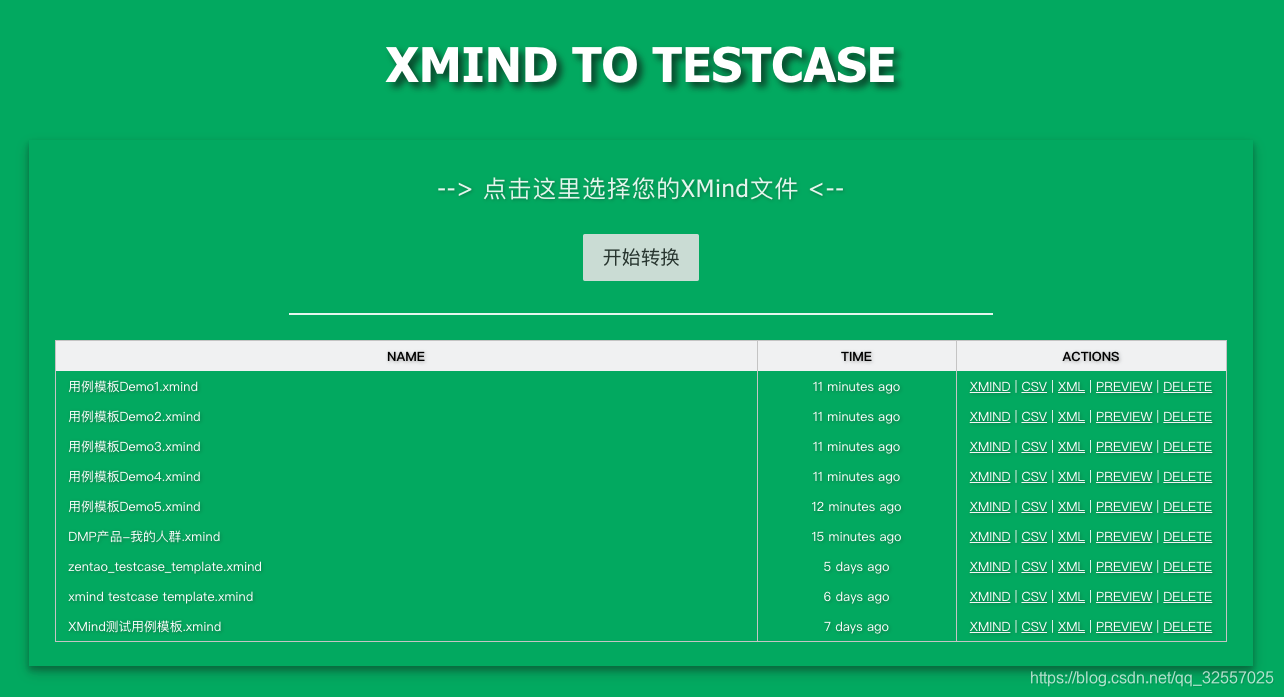
转换后用例预览

引用官方的说明
软件测试过程中,最重要、最核心就是测试用例的设计,也是测试童鞋、测试团队日常投入最多时间的工作内容之一。
然而,传统的测试用例设计过程有很多痛点:
基于这些情况,现在越来越多公司选择使用思维导图这种高效的生产力工具进行用例设计,特别是敏捷开发团队。
事实上也证明,思维导图其发散性思维、图形化思维的特点,跟测试用例设计时所需的思维非常吻合,所以在实际工作中极大提升了我们测试用例设计的效率,也非常方便测试用例评审。
但是与此同时,使用思维导图进行测试用例设计的过程中也带来不少问题:
于是,这时候 XMind2TestCase 就应运而生了,该工具基于 Python 实现,通过制定测试用例通用模板, 然后使用 XMind 这款广为流传且开源的思维导图工具进行用例设计。 其中制定测试用例通用模板是一个非常核心的步骤(具体请看使用指南),有了通用的测试用例模板,我们就可以在 XMind 文件上解析并提取出测试用例所需的基本信息, 然后合成常见测试用例管理系统所需的用例导入文件。这样就将 XMind 设计测试用例的便利与常见测试用例系统的高效管理结合起来了!
当前 XMind2TestCase 已实现从 XMind 文件到 TestLink 和 Zentao(禅道) 两大常见用例管理系统的测试用例转换,同时也提供 XMind 文件解析后的两种数据接口(TestSuites、TestCases 两种级别的 JSON 数据),方便快速与其他测试用例管理系统打通。
官方的示例
Web 转换工具

转换后用例预览

禅道(ZenTao)导入结果示例

pip3 install xmind2testcase
或者升级
pip3 install -U xmind2testcase
在开始之前先定义咋们的测试用例模板,官方的用例模板不太适合我的书写习惯,所以我把它稍微改改,先看看官网的,适合你就不用改啦。


我本地没搭建禅道,用 Excel 表格来展示,跟禅道一致。

1.case_apply_phase 属性:用例阶段我固定了功能测试
def gen_a_testcase_row(testcase_dict):
case_module = gen_case_module(testcase_dict['suite'])
case_title = testcase_dict['name']
case_precontion = testcase_dict['preconditions']
case_step, case_expected_result = gen_case_step_and_expected_result(testcase_dict['steps'])
case_keyword = ''
case_priority = gen_case_priority(testcase_dict['importance'])
case_type = gen_case_type(testcase_dict['execution_type'])
case_apply_phase = '功能测试'
# case_apply_phase = gen_case_apply_phase(testcase_dict['summary'])
'''生成测试用例的字段在这里'''
row = [case_module, case_title, case_precontion, case_step, case_expected_result, case_keyword, case_priority, case_type, case_apply_phase]
return row
测试阶段默认值转换
def gen_case_apply_phase(case_apply_phase):
if case_apply_phase=='无':
return '功能测试阶段'
else:
return case_apply_phase
2.把用例优先级的高中低换了下
# 没有定义用例优先级则默认3级
def gen_case_priority(priority):
# mapping = {1: '高', 2: '中', 3: '低'}
mapping = {1: 1, 2: 2, 3: 3,4:4}
if priority in mapping.keys():
return mapping[priority]
else:
return 3
1.把原先的产品名 (中心主题) 改为功能模块名,输出文件名字一致
def sheet_to_suite(root_topic):
"""convert a xmind sheet to a `TestSuite` instance"""
suite = TestSuite()
root_title = root_topic['title']
separator = root_title[-1]
if separator in config['valid_sep']:
logging.debug('find a valid separator for connecting testcase title: %s', separator)
config['sep'] = separator # set the separator for the testcase's title
root_title = root_title[:-1]
else:
config['sep'] = ' '
suite.name = root_title
# 直接用产品名字作为功能模块名
global my_title
my_title = root_title
suite.details = root_topic['note']
suite.sub_suites = []
for suite_dict in root_topic['topics']:
suite.sub_suites.append(parse_testsuite(suite_dict))
return suite
def parse_testsuite(suite_dict):
testsuite = TestSuite()
#直接用产品名字作为模块名,在sheet_to_suite定义全局变量my_title
testsuite.name = my_title
testsuite.details = suite_dict['note']
testsuite.testcase_list = []
logging.debug('start to parse a testsuite: %s', testsuite.name)
for cases_dict in suite_dict.get('topics', []):
for case in recurse_parse_testcase(cases_dict):
testsuite.testcase_list.append(case)
logging.debug('testsuite(%s) parsing complete: %s', testsuite.name, testsuite.to_dict())
return testsuite
3.用例类型和用例阶段设置
def parse_a_testcase(case_dict, parent):
testcase = TestCase()
topics = parent + [case_dict] if parent else [case_dict]
testcase.name = gen_testcase_title(topics)
preconditions = gen_testcase_preconditions(topics)
testcase.preconditions = preconditions if preconditions else '无'
summary = gen_testcase_summary(topics)
'''testcase.summary:用例阶段,配合gen_testcase_type使用'''
testcase.summary = summary if summary else '无'
execution_type = gen_testcase_type(topics)
'''testcase.execution_type:用例类型'''
testcase.execution_type = execution_type if execution_type else '无'
testcase.importance = get_priority(case_dict) or 2
step_dict_list = case_dict.get('topics', [])
if step_dict_list:
testcase.steps = parse_test_steps(step_dict_list)
# the result of the testcase take precedence over the result of the teststep
testcase.result = get_test_result(case_dict['markers'])
if testcase.result == 0 and testcase.steps:
for step in testcase.steps:
if step.result == 2:
testcase.result = 2
break
if step.result == 3:
testcase.result = 3
break
testcase.result = step.result # there is no need to judge where test step are ignored
logging.debug('finds a testcase: %s', testcase.to_dict())
return testcase
def gen_testcase_type(topics):
'''用例阶段调用'''
labels = [topic['label'] for topic in topics]
labels = filter_empty_or_ignore_element(labels)
return config['type_sep'].join(labels)
我这里需要改动的代码到这里结束了
这里说下我这里执行,官网有比较详细的执行教程点这里跳转
这段代码加在 zentao.py 下运行即可
if __name__ == '__main__':
xmind_file = '/Users/xxx/Downloads/xMind2testCase示例.xmind'
zentao_csv_file = xmind_to_zentao_csv_file(xmind_file)
print('Conver the xmind file to a zentao csv file succssfully: %s', zentao_csv_file)
使用命令,端口可自定义
xmind2testcase webtool 8000

用法:
xmind2testcase [path_to_xmind_file] [-csv] [-xml] [-json]
示例:
xmind2testcase /path/to/testcase.xmind => output testcase.csv、testcase.xml、testcase.json
xmind2testcase /path/to/testcase.xmind -csv => output testcase.csv
xmind2testcase /path/to/testcase.xmind -xml => output testcase.xml
xmind2testcase /path/to/testcase.xmind -json => output testcase.json
1.将 XMind 用例文件解析为禅道导入文件,用禅道的用例上传功能,把 xx.csv 上传即可
xmind2testcase XMind测试用例模板.xmind -csv ==> XMind测试用例模板.csv
2.将 XMind 用例文件转成 json 数据,用禅道的接口 post 上去,我本地没有环境,没法给出示例,有环境的小伙伴帮忙补充一下。
以上是根据我个人使用习惯来自定义,不一定适合各位小伙伴,有自定义需求的小伙伴可以看看源码或者留言评论私信。
